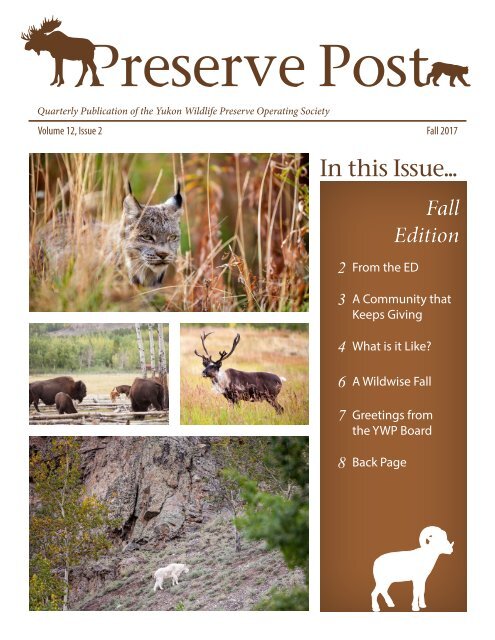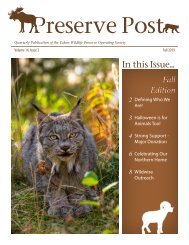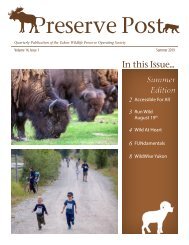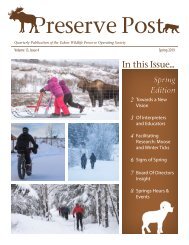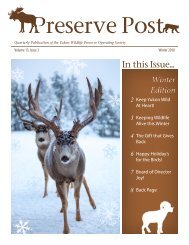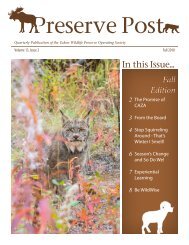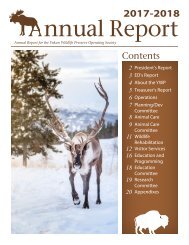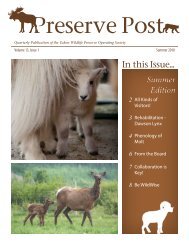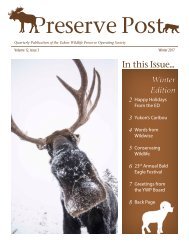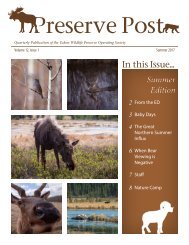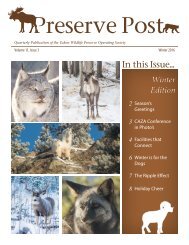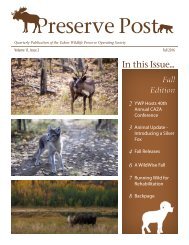2017 Fall Newsletter
Fall is such a wonderful season, full of change. The landscape and animals transform and behaviours change of both wild creatures and the human creatures too! Read here for the latest news and stories; notice and embrace the change yourself!
Fall is such a wonderful season, full of change. The landscape and animals transform and behaviours change of both wild creatures and the human creatures too! Read here for the latest news and stories; notice and embrace the change yourself!
You also want an ePaper? Increase the reach of your titles
YUMPU automatically turns print PDFs into web optimized ePapers that Google loves.
Quarterly Publication of the Yukon Wildlife Preserve Operating Society<br />
Volume 12, Issue 2<br />
<strong>Fall</strong> <strong>2017</strong><br />
In this Issue...<br />
2 From the ED<br />
3 A Community that<br />
Keeps Giving<br />
4 What is it Like?<br />
6 A Wildwise <strong>Fall</strong><br />
7 Greetings from<br />
the YWP Board<br />
8 Back Page<br />
<strong>Fall</strong><br />
Edition
Summer Greetings from the<br />
Wildlife Preserve<br />
In addition to being our busy tourism season, spring,<br />
summer and fall are when we tackle most of our<br />
improvement and development projects at the Wildlife<br />
Preserve.<br />
As some of you may have noticed, we are working<br />
on some improvements to our visitor reception area<br />
with new decking now in place. Next to come is the<br />
installation of two new, fully accessible outhouses and<br />
a connecting board walk. In mid-September we will<br />
be resurfacing all of our picnic tables and completing<br />
a landscaping project which will see the addition of<br />
some grassy berms, planting of indigenous plants and<br />
the transplanting of mature trees from around the<br />
Preserve<br />
Other behind-the-scene projects that we are presently<br />
undertaking include:<br />
• Completion of all new fencing for the large back<br />
cliff mountain goat habitat;<br />
• Updating from SECOR to COR level health &<br />
safety certification;<br />
• The building of a new 3,000 sq. ft. hay storage<br />
facility;<br />
• The removal of the old hay shed and the moving of<br />
our large gas tanks away from public view;<br />
• The building and installation of a new composting<br />
system;<br />
• The instalment of a new extra-large door at our<br />
garage which will allow us to store our tour bus<br />
and large loader overnight in a heated environment<br />
during the cold winter months;<br />
• Sourcing of funding and the selection of<br />
a contracting consortium to undertake a<br />
comprehensive ten-year Master Plan for the whole<br />
Preserve; and<br />
• In October, Highways & Public Works will be<br />
refurbishing all of our roads.<br />
To say that things are busy around the Preserve would<br />
be an understatement. The best part of all of this<br />
hard work, is that the months of June and July were<br />
the busiest months since YWP opened to the public<br />
thirteen years ago!<br />
Thank you to all of our valued members, Yukon<br />
residents and our visitors. None of this would be<br />
possible without your ongoing support.<br />
Cover photos, clockwise from top left: Lynx on the prowl,<br />
well camoflauged this time of year! Caribou groups have been<br />
seperated for the fall rut. The younger bull and females can<br />
be found in the left side pasture approaching the back cliff;<br />
Mountain goats amongst changing colours; Late birth - July born<br />
calf has yet to change to its darker coat.<br />
2<br />
Volume 12, Issue 2
A Community That Keeps Giving<br />
We always knew our non-profit charitable organzation was amongst a strong, supportive community. We would<br />
not be here without our generous and caring community members and organizations. This summer was the<br />
busiest on record and was marked by several grand<br />
gestures.<br />
We would like to take this time to recognize some<br />
important supporters of the Yukon Wildlife Preserve.<br />
Wildlife Saving Club - $71. 70<br />
Canyon Simanis & Hailey Steinhagen<br />
Raising funds for wildlife<br />
rehabilitation at YWP.<br />
Steven Smyth - $5,000. 00<br />
Donation in memory of his father<br />
Ron Smyth<br />
6 th Annual Run Wild <strong>2017</strong> - $875. 00<br />
Supporters helped raised money for wildlife rehabilitation, running for a cause!<br />
<strong>Fall</strong> <strong>2017</strong><br />
Top Right: Canyon and Hailey pose with their first Wildlife Saving Club advocacy<br />
poster (photo: CBC Phillipe Morin); Bottom: Annual Run Wild held on Discovery<br />
Day, racers are ready at the start line! (Photo: Erik Pinkerton).<br />
3
What is it Like?<br />
When working with animals, one of the most<br />
important things we can do for ourselves and<br />
our coworkers is communicate clearly. If you are<br />
asking a bird to fly to a certain perch without any<br />
success, a trainer needs<br />
to assess whether he or<br />
she communicated the<br />
ask effectively. It is hard<br />
to determine this unless<br />
one becomes practiced in<br />
empathy. At the American<br />
Bald Eagle Foundation, we<br />
are always trying to see things<br />
from the perspective of the<br />
birds. This can be a more<br />
difficult task than it sounds.<br />
One of the tools we use to<br />
guide interns is a paper<br />
written by American<br />
philosopher Thomas Nagle<br />
called What is it like to be<br />
a bat? In this paper, Nagle<br />
argues that an organism has<br />
conscious thought “if and<br />
only if there is something that<br />
it is like to be that organism.”<br />
Put simply, it is impossible<br />
to know what it is like to be<br />
a bat, but we know there is<br />
something that it is like. Nagle chooses a bat because<br />
although they are mammals, their experience is<br />
radically different from humans. We will never know<br />
what it is like to fly or echolocate, but guided by Nagle,<br />
we can respect that a bat has those experiences.<br />
Birds can be even more alien to us than bats. They have<br />
feathers instead of fur. Their eyes see colors and detail<br />
we can’t imagine. They lay eggs, they don’t have hands,<br />
the list goes on. Learning to empathize with these<br />
experiences makes us think outside of our own to look<br />
at a situation as it might seem to a bird. This allows us<br />
to identify a potential miscommunication and correct.<br />
Empathy can also be a demonstrative teaching tool. We<br />
love to guide guests through what life might look like<br />
through the eyes of a bird. By beginning to understand<br />
what life is like for a bird, many also consider the<br />
differences between individual experiences and<br />
recognize that each bird (deer, wolf, human, etc.)<br />
has a unique history and experience which drives<br />
Above: A bald eagle prepares to fly to a perch when her trainer gives<br />
her a clear cue.<br />
4<br />
Volume 12, Issue 2
the decisions they make. In<br />
other words, they have distinct<br />
personalities.<br />
The ability to recognize and<br />
respect different experiences and<br />
personalities is vital to successful<br />
animal training. It also allows us<br />
to effectively reach guests with<br />
our educational programming<br />
and to have more collaborative<br />
interactions with them.<br />
It all starts with one question:<br />
what is it like?<br />
Above: Museum Coordinator Katelyn Dickerson costumes<br />
a guest to imitate the raptor experience.<br />
Sidney Campbell is the Education<br />
and Outreach Coordinator at the<br />
American Bald Eagle Foundation<br />
in Haines, Alaska. She works to<br />
bring empowering wildlife education<br />
to Haines and surrounding<br />
communities by managing outreach,<br />
publications, and educational programming. She works with the Raptor Program<br />
Manager to train the avian ambassadors at the facility to take part in education and outreach.<br />
Visit the American Bald Eagle Foundation in Haines, Alaska. The facility is currently open<br />
Monday to Friday’s 9am - 5pm and Saturday`s 12pm-4pm.<br />
<strong>Fall</strong> <strong>2017</strong><br />
Above: The Preserve’s resident bald eagle now shares his home with<br />
a common raven. The raven came into the Preserve’s rehabilitation<br />
centre with a fractured humurs in July, it cannot fly. The two are<br />
often seen interacting. Come check out these iconic birds on your<br />
next visit!<br />
5
When Bear Viewing is Negative<br />
WildWise has had a busy summer!<br />
Our programs took us door to door<br />
in rural and urban Whitehorse<br />
subdivisions as well as to<br />
Carmacks. We talked with people<br />
about attractant management and<br />
collected data to better understand<br />
why there is still a problem with<br />
bears accessing human attractants<br />
such as garbage, bird feeders and<br />
chicken coops. We found that it is<br />
easy to engage with people about<br />
bears but that people are less<br />
willing to change their behavior<br />
to reduce human-bear conflict.<br />
The alternative to depending on<br />
education to fix the problem is to<br />
lean more heavily on policy and<br />
enforcement tools which, in turn,<br />
may affect human behavior. This<br />
has been one of the highest bear<br />
kill years on record at Conservation<br />
Officer Services. The only way to fix<br />
the problem is for people to change<br />
what they are doing, either by<br />
choice or by force.<br />
Perhaps our most talked about<br />
program this summer is our<br />
Skagway Road initiative which<br />
aims to reduce food conditioning<br />
along this well-traveled corridor.<br />
We responded to concerns from<br />
residents in this area, the Carcross/<br />
Tagish First Nation, Environment<br />
Yukon and Parks Canada by<br />
conducting research along the<br />
Skagway Road and<br />
encouraging people<br />
not to use highway<br />
shoulders for bear<br />
viewing and not to<br />
feed the bears. This is<br />
our most controversial<br />
campaign to date and<br />
we are busy compiling<br />
the data this month.<br />
We look forward to<br />
finding out what it<br />
says and to engaging<br />
with the public and<br />
stakeholders over the<br />
winter to find out what<br />
we should do next to<br />
keep bears and humans safe in this<br />
sensitive area.<br />
One last note. <strong>Fall</strong> is approaching,<br />
gardens are being harvested and<br />
livestock is being slaughtered. Bears<br />
are focused on consuming as many<br />
calories as possible. Please be safe<br />
this season. Use electric fencing<br />
around your attractants, make<br />
sure your properties are free from<br />
available attractants and let the<br />
bears pass through without trouble.<br />
Heather Ashthron is the Executive<br />
Director of Wildwise Yukon. For<br />
more information about this and<br />
other iniatives to reducing humanwildlife<br />
conflict visit www.wildwise.<br />
ca or give us a call at 335-5212. We<br />
would be happy to hear from you!<br />
6<br />
Bottom Left:.The new road sign as a part of the Skagway Road Initiative Top<br />
Right: Example of electric fencing in place mitigating conflict in order to protect<br />
livestock and of course, bears.<br />
Volume 12, Issue 2
Greetings from the Board<br />
Another summer is drawing<br />
to a close, the air is crisp with<br />
the hint of wood smoke, and<br />
the first frost has graced our<br />
yards… elk are bugling and<br />
the moose will be calling<br />
soon…. And that means<br />
the Yukon Wildlife Preserve<br />
Operating Society Board of<br />
Directors is getting their heads<br />
back into business for the<br />
winter!<br />
I wanted to take this<br />
opportunity to thank our<br />
fabulous group of volunteer<br />
Directors who tirelessly<br />
work to ensure the Preserve<br />
continues to meet its Mission<br />
and Vision and strategic<br />
direction. Tasked with<br />
determining and promoting<br />
the Preserve’s mandate, the<br />
board of directors also engages<br />
in active strategic planning<br />
to achieve those goals. This<br />
function is crucial, and to<br />
meet this mandate, we have a<br />
dynamite group of volunteers<br />
with a variety of backgrounds,<br />
from wildlife biology to<br />
accounting, business to zoo<br />
operations, planning to<br />
tourism.<br />
If you were not able to join<br />
us at our Annual General<br />
Meeting in July, but would like<br />
to get involved, please do not<br />
hesitate to get in touch with us<br />
directly. We are always open<br />
to energetic, dedicated, and<br />
engaged volunteers to join our<br />
Board or the Committees. If<br />
you have an interest in animal<br />
care, fundraising, finance, or<br />
communications, to name<br />
a few specific areas, please<br />
consider joining us!<br />
As many of you already<br />
are aware, we are entering<br />
into our next Master Plan<br />
process, which will result in<br />
both short- and long-term<br />
projects, specific direction for<br />
the various departments, and<br />
all things going as planned,<br />
financial security to ensure the<br />
Preserve remains the integral<br />
part of the Yukon tourism<br />
and natural environment<br />
destination that it is today.<br />
On behalf of the staff and<br />
Board of Directors, we thank<br />
you for your ongoing support<br />
and look forward to seeing<br />
you soon!<br />
Cheers,<br />
Alexandra Tait (de Jong<br />
Westman)<br />
President, Yukon Wildlife<br />
Preserve Operating Society<br />
Full-time Staff<br />
Yukon<br />
Wildlife<br />
Preserve<br />
Greg Meredith, Executive Director<br />
Randy Hallock, Director of Outdoor<br />
Operations<br />
Dr. Maria Hallock, Wildlife<br />
Veterinarian and Curator<br />
Jake Paleczny, Director of<br />
Programming & Education<br />
Lindsay Caskenette, Manager of<br />
Visitor Services<br />
Board of Directors<br />
Alexandra Tait President<br />
Shawna Warshawski, 1 st Vice-<br />
President<br />
Michael Kokiw, 2 nd Vice-President,<br />
Kristine Hildebrand, Treasurer<br />
Jessie Dawson<br />
Chris Evans<br />
Katelyn Friendship<br />
Kirk Cameron<br />
Brooke Rudolph<br />
Shirley Adamson<br />
Ed van Randen Non-voting Member<br />
- Environment Yukon<br />
Darrell March, Non-voting Member -<br />
Environment Yukon<br />
<strong>Fall</strong> <strong>2017</strong><br />
7
Above: Moosin’ around!<br />
Gettin’ Our Rut On. . .<br />
This is the season where ungulates battle for love.<br />
Watch for our antler and horn-bearing species compete<br />
with one another for rights to females! Typically there<br />
is a dominant male that breeds with the females. On<br />
your next visit to the<br />
Preserve, you may<br />
notice seperated male<br />
and female species<br />
groups. We intentially<br />
seperate genders for<br />
particular species as a<br />
form of birth control.<br />
This is an effort to help<br />
ensure the carrying<br />
capacities in each habitat<br />
is not exceeded by the<br />
number of individuals<br />
and our quality of care<br />
is not compromised<br />
becuase of the quanity<br />
of animals. This also<br />
allows us to maintain a<br />
good diversity of age and<br />
genetics.<br />
Writing: Lindsay Caskenette, Greg Meredith,<br />
8<br />
Sidney Campbell, Jake Paleczny, Heather Ashthorn, Alexandra<br />
Tait.<br />
Photos and illustrations: Lindsay Caskenette, Jake Paleczny, Erik<br />
Pinkerton, Phillipe Morin CBC .<br />
When to Visit<br />
Summer Hours<br />
9:30am to 6:00pm: Daily until October 9 th<br />
Guided Bus Tours at 10am, 12pm, 2pm & 4pm.<br />
Walk, run, bike anytime while open. Enjoy a safe,<br />
relaxed environment for the whole family!<br />
Winter hours Friday to Sunday’s start October<br />
10 th 10:30am to 4:00pm.<br />
Guided Bus tours at 12pm, & 2pm<br />
Curious about the latest news? Visit<br />
facebook.com/yukonwildlife or call 456-7300.<br />
We’re Social - join us on Instragram!<br />
Share your adventures with us through Social<br />
Media and we`ll re-share our favs!<br />
Tag us #YukonWildlife<br />
Printed on 100% Recycled Volume Paper 12, Issue 2


